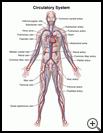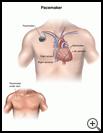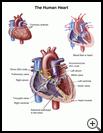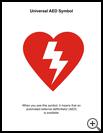
Cardiac Dysrhythmia Discharge Information
What is a cardiac dysrhythmia?
A normal, healthy heart has a regular rhythm and beats between 50 and 100 times per minute.
A cardiac dysrhythmia (also called an arrhythmia) is an abnormal rhythm of your heartbeat. It can be slower or faster than a normal heart rate. It can also be irregular. It can be life-threatening if the heart cannot pump enough oxygen-rich blood to your heart or the rest of your body.
A cardiac dysrhythmia can be caused by many things, including problems with the heart valves, coronary artery disease, heart failure, drug use, and some medicines. Common types of dysrhythmia include:
- Atrial fibrillation: In atrial fibrillation the upper chambers of the heart do not squeeze (contract) in an organized way and are not working with the lower chambers. This affects the ability of the heart to pump blood.
- Atrial flutter: In atrial flutter, the upper chambers of the heart beat faster than the lower chambers of the heart, which causes less blood to be pumped to the body.
- Multifocal atrial tachycardia: In multifocal atrial tachycardia, too many signals are sent from the upper chambers of the heart to the lower chambers, causing a very fast heart rate.
- Bradycardia: In bradycardia, your heart beats very slowly.
- Paroxysmal supraventricular tachycardia (PSVT): This is a rapid heart rate that happens off and on and starts in the upper chambers of the heart.
- Ventricular tachycardia: The heart's lower chambers beat in a regular rhythm but very fast. This abnormality is usually caused by heart disease. It can be caused by medicine you are taking. Continuous ventricular tachycardia can be a life threatening condition if not treated right away.
- Ventricular fibrillation: The heart muscle quivers and is uncoordinated. This prevents the heart from pumping. This is usually a lethal condition if not treated right away.
- Various degrees of heart block:
- First-degree heart block: The electrical signals are only slightly slowed. You may not have symptoms. First-degree heart block is common.
- Second-degree heart block: Some of the electrical signals do not reach your heart’s lower chambers. Your heart rate gets slow or irregular. Continuous second degree heart block can be life threatening and needs to be treated right away.
- Third-degree block (complete heart block): The electrical signal from the upper chambers does not reach the lower chambers. The upper and lower chambers do not work together. Your heart may not be able to pump enough blood and oxygen to your brain and the rest of your body. This is usually a lethal condition if not treated right away.
How can I take care of myself when I go home?
How long it takes to get better depends on the cause of your dysrhythmia, your treatment, how well you recover, your overall health, and any complications you may have. When you have an abnormal heart rhythm, you need to make lifestyle changes to be healthier and to help keep from having other complications. There are several things you can do.
Management
- Your provider will give you a list of your medicines when you leave the hospital.
- Know your medicines. Know what they look like, how much you should take each time, how often you should take them, and why you take each one.
- Take your medicines exactly as your provider tells you to.
- Carry a list of your medicines in your wallet or purse. Include any nonprescription medicines and supplements on the list.
- Talk to your provider before you use any other medicines, including nonprescription medicines.
- Your provider may prescribe medicine to:
- Help slow the heart rate, reduce blood pressure, and reduce the workload of the heart
- Help the heart to beat normally
- Prevent blood clots
- Your provider may recommend other types of therapy to help relieve pain, other symptoms, or side effects of treatment.
- If you have had surgery, to care for your surgical wound:
- Keep your surgical wound clean.
- If you are told to change your dressing on your surgical wound, wash your hands before changing the dressing and after disposing of the dressing.
Appointments
- Follow your provider's instructions for follow-up appointments.
- Keep appointments for any testing you may need.
- Talk with your provider about any questions or concerns you have.
Diet, Exercise, and Other Lifestyle Changes
- Follow the treatment plan your healthcare provider prescribes.
- Get plenty of rest while you’re recovering. Try to get at least 7 to 9 hours of sleep each night.
- You may need to make changes in some of the foods you eat. Ask your provider about the benefits of talking to a dietician to learn what you need in a healthy diet. Some foods and medicines can change the effects of blood thinners.
- Drink enough fluids to keep your urine light yellow in color, unless you are told to limit fluids.
- Exercise as your provider recommends.
- Lose weight if you need to and keep a healthy weight.
- Don’t smoke.
- Find ways to lower your stress level.
Call emergency medical services or 911 if you have new or worsening:
- Chest pain or pressure, squeezing, or fullness in the center of your chest that lasts more than few minutes, or goes away and comes back (may feel like indigestion or heartburn)
- Pain or discomfort in one or both arms or shoulders, or in your back, neck, jaw, or stomach
- Trouble breathing
- Breaking out in a cold sweat for no known reason
- If your provider has prescribed nitroglycerin for angina, pain that does not go away after taking your nitroglycerin as directed
- Along with the previous symptoms, feeling very tired, faint, or sick to your stomach
If you have any of these symptoms, do not drive yourself.
Call your healthcare provider if you have new or worsening:
- Feeling like your heart is beating too fast, too slow, or skipping beats
- Tiredness
- Signs of infection around your surgical wound if you had surgery. These include:
- The area around your wound is more red or painful
- The wound area is very warm to touch
- You have blood, pus, or other fluid coming from your wound area
- You have a fever higher than 101.5° F (38.6° C)
- You have chills or muscle aches
Ask your healthcare provider about any medicine, treatment, or information that you do not understand.
Last modified: 2016-04-19
Last reviewed: 2016-04-19




